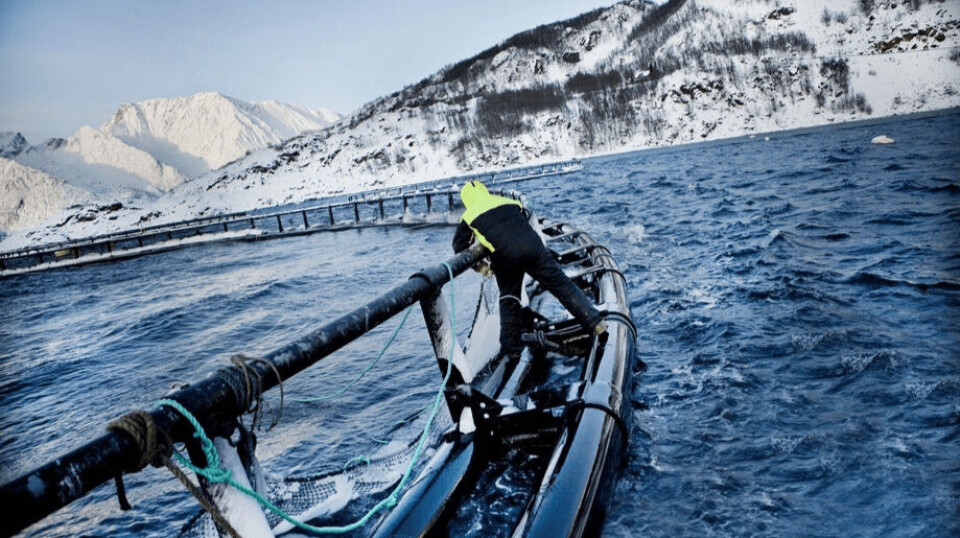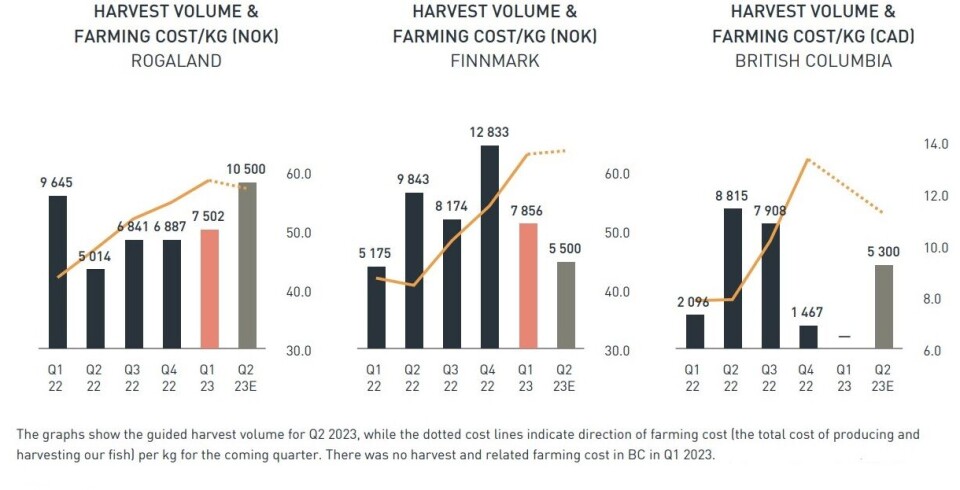
Early harvesting pegs back profit for Grieg
Norway and Canada salmon farmer Grieg Seafood made an operating profit of NOK 385 million (£28.7m / CAD 48.5m) in the first quarter of this year, 15% less than the NOK 453m operational EBIT in Q1 2022.
Earnings were impacted by early harvests in its two Norway regions, Rogaland and Finnmark, due to biological issues.
In Rogaland, southwest Norway, Grieg harvested 7,502 gutted weight tonnes (Q1, 2022: 9,645 gwt), which was 2,200 tonnes above guidance due to advance harvesting to reduce biological risk related to ISA (infectious salmon anaemia) at one site and winter ulcers.
In Finnmark, northern Norway, Grieg harvested 7,856 gwt (5,175 gwt), 2,100 tonnes above guidance due to advance harvesting related to handling of the Sprio parasite (Spironucleus salmonicida) and winter ulcers. Fish were infected with Spiro at a freshwater facility which has since been fitted with an upgraded ultraviolet (UV) disinfection system.
Lower weights
Price achievement in both Norway regions was impacted by reduced superior share and reduced average harvest weights, as well as a negative contribution from pre-contracted fish sales. Operational EBIT per kilo in Rogaland was NOK 38.4, and in Finnmark it was NOK 20.1.
There were no harvests in Canada in Q1. The company kept fish in the water in British Columbia to build up biomass, and its first crop in Placentia Bay, Newfoundland, is not yet ready for harvest.
“We were still impacted by biological challenges in the beginning of the year, though biology improved throughout the quarter and is currently good in Rogaland, BC and Newfoundland,” wrote chief executive Andreas Kvame in Grieg’s Q1 2023 report.
“The fish in Newfoundland handled a cold winter in the sea well and the development of the region is going according to plan.
Mitigating measures
“Like in the previous quarter, Finnmark is still impacted by the Spiro parasite. Mitigating measures have been taken to address the issues, including early harvesting to reduce risk, resulting in harvesting volumes above guiding and plan.
“There were no new incidents of Spiro at the freshwater facility during the quarter, and with increased smolt release in 2023 we aim to compensate for the early harvest and to accelerate rebuilding the biomass.”
Grieg has a strategy of stocking large post-smolts, and the average weight of smolts transferred to sea in Rogaland in Q1 was 720 grams.
However, the company said extra stocking is not expected to fully compensate for the lost biomass in Q1, and the 2023 harvest target for Finnmark is reduced from 28,000 to 26,000 tonnes.
Canada
Grieg reported good seawater performance in BC in Q1, with the 12-month rolling survival rate coming to 92%. However, due to sea lice treatments and winter ulcers, the cost of reduced survival was NOK 13.1 million in Q1 2023, compared to NOK 0.2 million in Q1 2022.
In Placentia Bay, Newfoundland, Grieg is using triploid fish as it is required to grow sterile, all-female salmon to eliminate the risk of genetic pollution of wild Atlantic salmon in case of escape.
“Triploid salmon perform well in cold environments and do not mature,” reported Grieg. “So far, the fish have performed well biologically, with high survival and growth at sea, and we have not experienced sea lice issues. Despite seawater temperatures close to zero degrees during the quarter, we did not experience reduced survival.
80,000 tonnes
“At the end of Q1 2023, we had approximately 3,100 tonnes biomass at sea with an average weight of 1.6 kg. We are still in an early phase and will expand the project gradually and in line with biological developments. Harvesting is expected to commence towards the end of 2023.”
The company expects to stock more smolts from its freshwater facility in Marystown, Newfoundland, during late spring or summer this year.
Grieg is guiding for a full-year harvest of 80,000 gwt, of which 29,000 gwt will come from Rogaland, 26,000 gwt from Finnmark, 20,000 gwt from BC, and 5,000 gwt from Newfoundland.























































